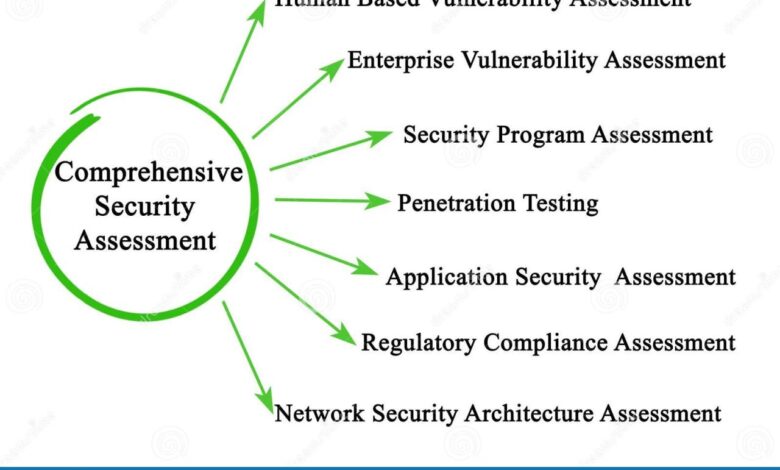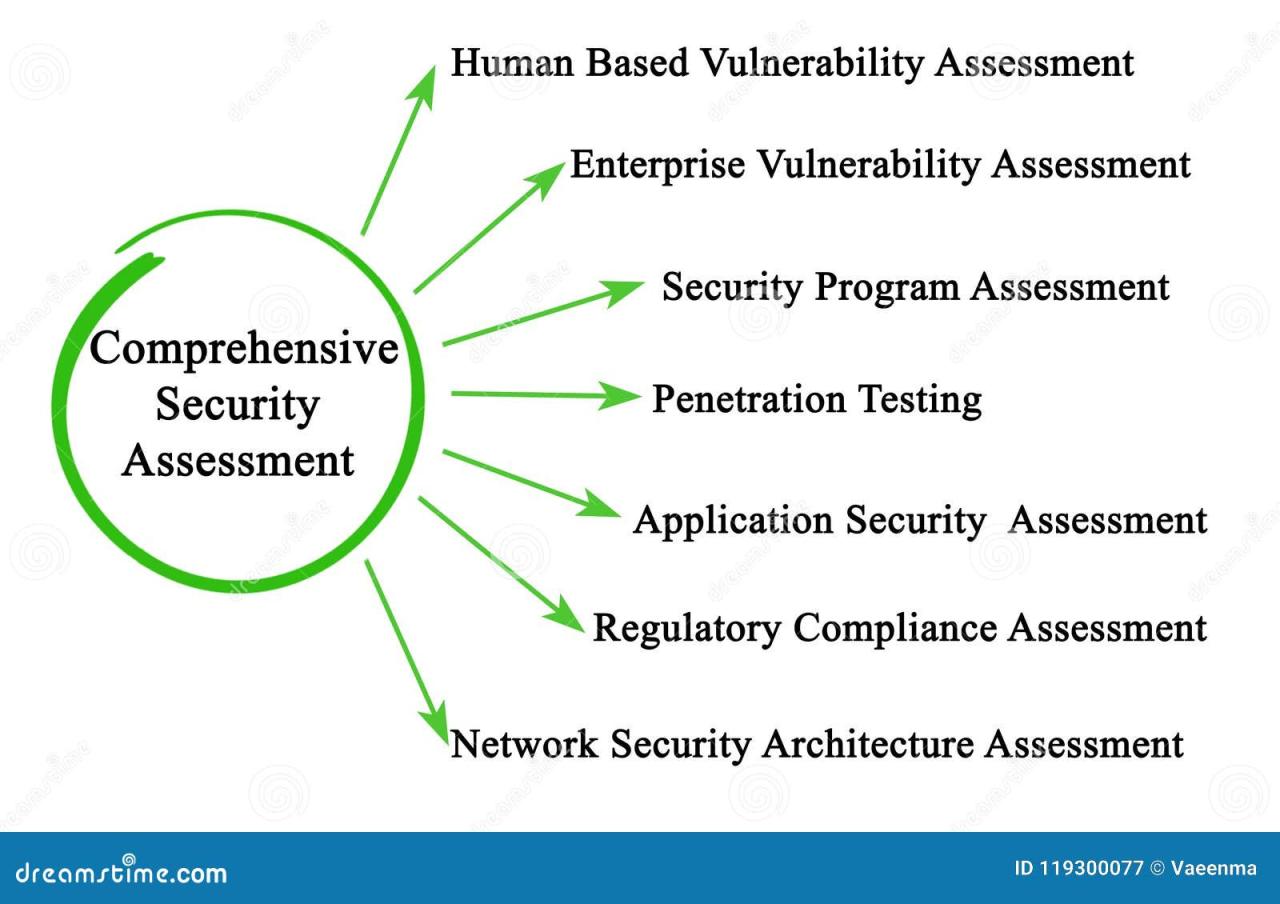
Across the Board Security A Holistic Approach
Across the Board Security isn’t just a buzzword; it’s the bedrock of a truly safe digital environment. Think of it as building a fortress, not just reinforcing a single wall. This means layering security measures across every aspect of your system – from your network and devices to your employees and data. We’ll dive into the strategies, technologies, and human elements that make this comprehensive approach a necessity in today’s threat landscape.
This post explores the multifaceted nature of across-the-board security, from defining its core components and implementation strategies to addressing emerging threats and measuring its effectiveness. We’ll unpack the technical aspects, highlighting essential technologies and the critical role of cybersecurity awareness training. Furthermore, we’ll delve into the human element, emphasizing the importance of employee training, security policies, and minimizing the impact of human error.
Ultimately, our goal is to empower you with the knowledge to build a robust and resilient security posture.
Defining “Across the Board Security”
Across-the-board security isn’t just about patching vulnerabilities or installing antivirus software; it’s a holistic approach to protecting an organization’s entire ecosystem. It’s about recognizing that security isn’t a single point of failure, but a complex network of interconnected systems and processes, each requiring its own level of protection. A truly robust strategy considers every aspect of the organization, from physical infrastructure to digital assets and human behavior.This comprehensive approach necessitates a layered security model, proactively addressing potential threats at every stage.
It’s about building a defense in depth, making it significantly harder for attackers to breach your defenses. The goal is to minimize risk and maximize resilience, ensuring business continuity even in the face of a successful attack.
Key Components of a Robust Across-the-Board Security Strategy
A robust across-the-board security strategy incorporates several critical components working in concert. These components are not isolated but rather interwoven to create a comprehensive and resilient security posture. Failing to address any single component significantly weakens the overall effectiveness of the strategy.
For example, a company might have state-of-the-art firewalls and intrusion detection systems, but if their employees fall victim to phishing scams, the entire system is compromised. Similarly, a strong physical security system is useless if data is inadequately protected in the cloud.
Layers of Security in an Across-the-Board Approach
Across-the-board security employs a multi-layered approach, creating a defense-in-depth strategy. Each layer adds another obstacle for potential attackers, making it exponentially more difficult to successfully penetrate the system. These layers often overlap and reinforce each other, creating a robust and resilient security posture.
Consider a typical organization’s security architecture. The perimeter is protected by firewalls and intrusion prevention systems. Internal networks are segmented to limit the impact of a breach. Data is encrypted both in transit and at rest. Employees receive regular security awareness training.
Incident response plans are in place to handle security incidents effectively. Each layer is vital, and a weakness in one can compromise the entire system.
Physical Security Measures
Physical security forms the foundational layer, encompassing measures to protect physical assets like buildings, servers, and data centers. This includes access control systems (e.g., keycard readers, security guards), surveillance systems (CCTV cameras, motion detectors), and environmental controls (temperature regulation, fire suppression). A strong physical security posture prevents unauthorized access to sensitive equipment and data, forming the first line of defense.
For example, a data center might use biometric authentication combined with multi-factor authentication to control access, creating a robust barrier against physical intrusion.
Network Security Measures
Network security focuses on protecting the organization’s network infrastructure and data transmitted across it. This involves firewalls to control network traffic, intrusion detection/prevention systems to monitor for malicious activity, virtual private networks (VPNs) to secure remote access, and regular security audits and penetration testing to identify vulnerabilities. A well-defined network security strategy helps to contain the spread of malware and prevent unauthorized access to sensitive data.
For instance, a company might implement a zero-trust network access model, verifying every user and device before granting access to resources, regardless of location.
Data Security Measures
Data security encompasses all measures to protect an organization’s sensitive data, regardless of its location (on-premises, cloud, or mobile devices). This includes data encryption (both in transit and at rest), access control mechanisms (role-based access control, least privilege), data loss prevention (DLP) tools, and regular data backups. Data security protocols must adhere to relevant regulations and industry best practices.
Consider a healthcare provider implementing strict HIPAA compliance measures, including data encryption and audit trails, to protect patient health information.
Application Security Measures
Application security focuses on securing the software applications used by the organization. This includes secure coding practices, vulnerability scanning, penetration testing, and regular software updates to patch known vulnerabilities. Secure application development is crucial to prevent vulnerabilities from being introduced into the system in the first place. A financial institution, for instance, might employ static and dynamic application security testing to identify and remediate vulnerabilities in its online banking platform before deployment.
Human Element and Security Awareness Training
The human element is often the weakest link in any security chain. Security awareness training educates employees about common threats (phishing, social engineering, malware) and best practices for protecting sensitive information. Regular training and simulated phishing campaigns help to build a security-conscious culture within the organization. A company might use interactive training modules and regular quizzes to reinforce employee understanding of security best practices.
Implementation Strategies for Across-the-Board Security
Implementing across-the-board security isn’t a single event; it’s a journey requiring careful planning and execution. A phased approach allows for manageable implementation, minimizing disruption and maximizing effectiveness. This approach also allows for continuous improvement and adaptation as the organization’s needs and threat landscape evolve.
Phased Implementation Plan
A phased rollout allows for controlled deployment and iterative improvements. This table Artikels a potential plan, adaptable to different organizational contexts. Remember that timelines are estimates and should be adjusted based on your organization’s specific resources and complexity.
| Phase | Timeline | Key Deliverables | Metrics |
|---|---|---|---|
| Assessment & Planning | 1-3 months | Comprehensive risk assessment, security policy development, budget allocation, team formation. | Completed risk register, approved security policy, allocated budget, team roster. |
| Infrastructure Hardening | 3-6 months | Implementation of firewalls, intrusion detection systems (IDS), vulnerability scanning, patching of critical vulnerabilities, network segmentation. | Number of vulnerabilities remediated, uptime, successful penetration testing results. |
| Endpoint Security | 2-4 months | Deployment of endpoint detection and response (EDR) solutions, antivirus software, data loss prevention (DLP) tools, employee security awareness training. | Number of endpoints protected, reduction in malware incidents, employee training completion rates. |
| Data Security & Access Control | 4-6 months | Implementation of access control lists (ACLs), data encryption, regular data backups, disaster recovery planning, compliance audits. | Data breach incident rate, data recovery time, compliance audit results. |
| Continuous Monitoring & Improvement | Ongoing | Security Information and Event Management (SIEM) implementation, regular security audits, vulnerability scanning, penetration testing, security awareness training refreshers. | Mean time to detect (MTTD), mean time to respond (MTTR), number of security incidents. |
Integrating Security Measures
Integrating security into existing systems and workflows requires a delicate balance between enhanced protection and operational efficiency. Gradual implementation, coupled with thorough testing and employee training, is crucial to avoid disruption. For example, introducing multi-factor authentication (MFA) can be rolled out in stages, starting with high-risk accounts and gradually expanding to all users. Regular communication and feedback mechanisms are essential to address concerns and ensure smooth adoption.
Careful consideration should be given to the integration points, potential conflicts, and fallback mechanisms. Pilot programs are highly recommended before full-scale deployment.
Risk Assessment and Mitigation Approaches
Different approaches to risk assessment and mitigation exist, each with its strengths and weaknesses. Quantitative risk assessment utilizes numerical data to calculate the likelihood and impact of threats, offering a more objective view. Qualitative risk assessment relies on expert judgment and subjective assessments, suitable for situations where precise data is lacking. A hybrid approach, combining both quantitative and qualitative methods, often provides the most comprehensive understanding.
Mitigation strategies should be tailored to the specific risks identified, prioritizing those with the highest potential impact. For instance, a high-impact, low-likelihood risk might be mitigated through insurance, while a high-impact, high-likelihood risk would necessitate more proactive measures such as implementing robust security controls. Regular review and updating of the risk assessment and mitigation plan are essential to adapt to evolving threats and vulnerabilities.
Technological Aspects of Across-the-Board Security
Implementing truly comprehensive security, what we call “across-the-board security,” requires a robust technological foundation. This goes beyond simply installing antivirus software; it demands a layered approach integrating multiple technologies working in concert to protect your organization at every level. This integrated approach is crucial for mitigating risks and ensuring business continuity.
Effective across-the-board security relies on a synergistic combination of network security, endpoint protection, data loss prevention (DLP), and a strong emphasis on employee training. These technologies, when properly implemented and maintained, create a formidable defense against modern cyber threats.
Network Security Technologies
Network security forms the bedrock of any robust security posture. It involves implementing measures to protect the network infrastructure and data transmitted across it. This includes firewalls, intrusion detection and prevention systems (IDS/IPS), virtual private networks (VPNs), and secure web gateways. Firewalls act as the first line of defense, filtering traffic based on predefined rules. IDS/IPS systems monitor network traffic for malicious activity, alerting administrators to potential threats or automatically blocking them.
VPNs encrypt data transmitted over public networks, protecting sensitive information from eavesdropping. Secure web gateways filter and inspect web traffic, preventing access to malicious websites and protecting against phishing attacks. The combined effect of these technologies creates a multi-layered defense against network-based attacks.
Endpoint Protection
Endpoint protection focuses on securing individual devices such as laptops, desktops, and mobile phones. This typically involves deploying endpoint detection and response (EDR) solutions, antivirus software, and data encryption. EDR solutions provide advanced threat detection and response capabilities, going beyond traditional antivirus by monitoring system behavior for suspicious activities. Antivirus software remains crucial for detecting and removing malware. Data encryption protects sensitive data stored on endpoints, even if the device is lost or stolen.
The integration of these technologies ensures that individual devices are protected from both internal and external threats.
Data Loss Prevention (DLP)
Data loss prevention (DLP) technologies aim to prevent sensitive data from leaving the organization’s control. This involves monitoring data movement, identifying sensitive information, and blocking or alerting on unauthorized transfers. DLP solutions can be implemented at the network level, endpoint level, or both, providing comprehensive protection against data breaches. They often utilize data classification and identification techniques to pinpoint sensitive data, regardless of its format or location.
By implementing DLP, organizations can significantly reduce the risk of data breaches and maintain compliance with relevant regulations.
Cybersecurity Awareness Training
Technology alone is insufficient to guarantee comprehensive security. Human error remains a significant vulnerability. Therefore, a robust cybersecurity awareness training program is crucial for strengthening the overall security posture.
- Regular training sessions: Employees should receive regular training on topics such as phishing awareness, password security, and safe browsing practices.
- Simulated phishing attacks: Conducting simulated phishing attacks helps assess employee vulnerability and reinforce training effectiveness.
- Incident reporting procedures: Employees should be trained on how to report security incidents promptly and effectively.
- Policy enforcement: Regular reinforcement of security policies ensures that employees understand and adhere to them.
Successful Deployment Scenario
Imagine a financial institution implementing across-the-board security. Their network is protected by a state-of-the-art firewall and an intrusion prevention system, constantly monitoring for malicious activity. All endpoints (laptops, desktops) have EDR software installed, actively monitoring for suspicious behavior and automatically blocking threats. A DLP system prevents sensitive financial data from leaving the network unauthorized, even via removable media or cloud services.
Finally, employees undergo regular cybersecurity awareness training, including simulated phishing attacks, ensuring they are vigilant against social engineering attempts. In this scenario, a sophisticated phishing attack targeting an employee is detected by the EDR solution on their endpoint before it can compromise the network. The firewall and IPS block any subsequent attempts to infiltrate the network, while the DLP system prevents any data exfiltration.
Across-the-board security is crucial in today’s digital landscape, impacting every aspect of application development. Building robust security into applications from the ground up is essential, and this is especially relevant when considering the rapid development capabilities offered by low-code/no-code platforms. For a deep dive into how this works in practice, check out this insightful article on domino app dev the low code and pro code future , which highlights the importance of integrating security considerations throughout the development lifecycle.
Ultimately, prioritizing security ensures a safer and more reliable application, regardless of the development approach.
The combination of these technologies and a well-trained workforce ensures a robust and effective security posture.
Human Factors in Across-the-Board Security: Across The Board Security
The effectiveness of any security system, no matter how technologically advanced, hinges significantly on the human element. Across-the-board security strategies must account for the inherent vulnerabilities introduced by human behavior, both intentional and unintentional. Addressing these vulnerabilities requires a multifaceted approach encompassing robust training, clearly defined policies, and a proactive culture of security awareness.Employee training and education are fundamental pillars in maintaining a strong security posture.
A well-trained workforce is less likely to fall victim to phishing scams, social engineering attacks, or inadvertently compromise sensitive data through careless actions. This training should be ongoing and tailored to the specific roles and responsibilities of each employee, ensuring that they understand the potential risks and their role in mitigating them.
Employee Training and Education in Maintaining Security
Effective employee training programs go beyond simple awareness sessions. They should incorporate practical exercises, simulations, and regular refresher courses to reinforce learned behaviors. For instance, simulated phishing attacks can help employees identify suspicious emails and avoid clicking on malicious links. Regular updates on evolving threats and best practices ensure that employees remain vigilant against emerging security challenges. Furthermore, training should clearly Artikel the consequences of security breaches, emphasizing both the organizational and personal repercussions.
This approach fosters a sense of shared responsibility and encourages proactive participation in maintaining security.
The Impact of Human Error on Security Breaches and Strategies for Minimization, Across the board security
Human error remains a leading cause of security breaches. Simple mistakes, such as forgetting a password or leaving a laptop unattended, can have devastating consequences. To minimize these risks, organizations should implement multi-factor authentication (MFA) wherever possible, enforce strong password policies, and provide secure storage solutions for sensitive data. Regular security audits and vulnerability assessments can help identify weaknesses in existing security protocols and highlight areas where human error is most likely to occur.
Furthermore, clear communication channels and incident reporting mechanisms should be established to encourage employees to report security concerns without fear of retribution. This fosters a culture of openness and accountability, crucial for effective security management. A real-world example is the Target data breach of 2013, where a third-party vendor’s compromised credentials allowed attackers access to the retailer’s systems, highlighting the critical role of vendor security in overall organizational security.
The Role of Security Policies and Procedures in Establishing a Culture of Security
Comprehensive and clearly articulated security policies and procedures are essential for establishing a strong security culture. These policies should cover all aspects of security, from password management and data handling to acceptable use of company resources and incident response procedures. Crucially, these policies must be easily accessible and understandable to all employees. Regular review and updates of these policies are necessary to keep pace with evolving threats and technological advancements.
Consistent enforcement of these policies, along with regular audits and assessments, ensures that they remain effective and relevant. Moreover, integrating security considerations into the organization’s overall risk management framework demonstrates a commitment to security at all levels. This proactive approach fosters a culture of security awareness and responsibility, minimizing the likelihood of human error leading to security breaches.
Addressing Emerging Threats with Across-the-Board Security

The ever-evolving landscape of cybersecurity necessitates a proactive and comprehensive approach to security. Across-the-board security, by its very nature, is designed to be adaptable and resilient, allowing organizations to better withstand and respond to emerging threats. Failing to address these new threats effectively can lead to significant financial losses, reputational damage, and legal repercussions. A robust, adaptable security strategy is crucial for survival in today’s digital world.
Emerging Threats and Mitigation Strategies
The following table details three significant emerging cybersecurity threats and how an across-the-board security approach can mitigate their impact. These threats highlight the need for a holistic strategy that considers technological, human, and procedural aspects of security.
| Threat | Impact | Mitigation Strategy |
|---|---|---|
| AI-powered phishing and social engineering attacks | Increased sophistication of attacks leading to higher success rates in bypassing traditional security measures, resulting in data breaches, financial losses, and reputational damage. These attacks can be incredibly difficult to detect because they mimic legitimate communications so effectively. | Employ advanced threat detection systems that leverage AI and machine learning to identify and block sophisticated phishing attempts. Implement robust security awareness training programs to educate employees on identifying and reporting suspicious emails and messages. Multi-factor authentication (MFA) should be mandatory across all systems and accounts. Regular security audits and penetration testing are crucial to identify vulnerabilities before attackers exploit them. |
| Supply chain attacks | Compromise of third-party vendors or software supply chains can grant attackers access to an organization’s systems and data, leading to widespread data breaches, operational disruptions, and significant financial losses. The impact can extend far beyond the initial point of compromise. | Implement rigorous vendor risk management programs, including thorough due diligence and security assessments of all third-party vendors. Utilize secure software development practices and implement robust code review processes. Employ a zero-trust security model, limiting access based on verified identity and context, rather than relying on network perimeters. Regularly monitor the security posture of your supply chain partners. |
| Quantum computing threats to cryptography | The development of powerful quantum computers poses a significant threat to current encryption algorithms, potentially rendering sensitive data vulnerable to decryption. This could lead to massive data breaches and the compromise of critical infrastructure. | Begin researching and implementing post-quantum cryptography (PQC) algorithms. This involves transitioning to cryptographic methods that are resistant to attacks from quantum computers. This is a long-term strategy requiring careful planning and phased implementation. Invest in research and development efforts to stay ahead of the curve in quantum-resistant cryptography. Collaborate with industry partners and government agencies to share best practices and accelerate the transition. |
Adapting Across-the-Board Security for Future Threats
Organizations must adopt a dynamic and iterative approach to across-the-board security. This involves continuous monitoring of the threat landscape, regular security assessments, and a commitment to continuous improvement. Staying informed about emerging threats through industry publications, threat intelligence feeds, and participation in security communities is crucial. Regularly reviewing and updating security policies, procedures, and technologies is essential to ensure they remain effective against evolving threats.
Investing in skilled cybersecurity professionals and providing them with ongoing training is also critical. Furthermore, fostering a security-conscious culture within the organization, where employees are actively involved in identifying and reporting security risks, is paramount. Regular vulnerability scanning and penetration testing can proactively identify weaknesses before attackers exploit them. Finally, developing robust incident response plans and conducting regular drills ensures that the organization is prepared to effectively manage and mitigate the impact of security incidents.
Measuring the Effectiveness of Across-the-Board Security
Implementing a comprehensive across-the-board security strategy is only half the battle. The other, equally crucial half, involves rigorously measuring its effectiveness. This ensures that resources are allocated efficiently, weaknesses are identified and addressed promptly, and the overall security posture is continuously improved. Without consistent measurement, a security program risks becoming stagnant and ineffective, leaving the organization vulnerable.
Methods for Measuring Security Effectiveness
Several methods can be employed to gauge the success of an across-the-board security strategy. These methods should be tailored to the specific organization’s needs and risk profile, encompassing both quantitative and qualitative assessments. A balanced approach is essential for a holistic understanding of security performance.
Quantitative methods focus on measurable data. Examples include analyzing the number of successful and unsuccessful security breaches, tracking the time taken to resolve incidents, and measuring the cost of security incidents. Qualitative methods, on the other hand, focus on subjective assessments, such as employee satisfaction with security training and the perceived effectiveness of security awareness programs. Regular security audits, penetration testing, and vulnerability assessments are also crucial quantitative methods.
They provide a snapshot of the organization’s current security posture and identify areas needing improvement.
Key Performance Indicators (KPIs) for Across-the-Board Security
Tracking key performance indicators (KPIs) is vital for monitoring progress and identifying areas needing improvement. These metrics provide quantifiable data to support decision-making and demonstrate the return on investment (ROI) of security initiatives.
Examples of relevant KPIs include:
- Mean Time To Detect (MTTD): The average time it takes to identify a security incident.
- Mean Time To Respond (MTTR): The average time it takes to resolve a security incident.
- Number of Security Incidents: The total number of security incidents detected over a specific period.
- Number of successful phishing attacks: A measure of the effectiveness of security awareness training.
- Percentage of vulnerabilities remediated: Tracks the organization’s ability to address identified vulnerabilities.
- Employee security awareness training completion rate: Measures the participation rate in security training programs.
- Cost of security incidents: Includes direct and indirect costs associated with breaches.
Visual Representation of KPI Contributions
A radar chart can effectively illustrate the contribution of different KPIs to the overall assessment of security effectiveness. Imagine a radar chart with axes representing each KPI (MTTD, MTTR, Number of Security Incidents, etc.). Each axis would have a scale indicating performance levels (e.g., excellent, good, fair, poor). Each KPI’s performance would be plotted on its respective axis, creating a polygon.
A larger, more centrally located polygon indicates stronger overall security effectiveness, while a smaller, irregularly shaped polygon suggests areas needing improvement. For example, a large polygon might indicate a robust security posture, while a polygon with a significantly lower point on the “Number of Security Incidents” axis would signal a need for enhanced incident prevention measures. The visual representation provides a clear and concise summary of the organization’s security performance across various dimensions.
Wrap-Up

Building across-the-board security isn’t a one-time project; it’s an ongoing process of adaptation and improvement. By understanding the interconnectedness of technology, human factors, and emerging threats, you can create a security strategy that evolves with the ever-changing digital landscape. Remember, a truly secure environment requires a multi-layered approach that considers every aspect of your organization, from the smallest detail to the grand strategy.
The journey towards comprehensive security is a continuous one, but the rewards – a safe and productive digital space – are well worth the effort.
Quick FAQs
What is the difference between across-the-board security and perimeter security?
Perimeter security focuses solely on external threats, while across-the-board security encompasses all aspects, including internal threats and vulnerabilities.
How much does implementing across-the-board security cost?
The cost varies greatly depending on the size and complexity of your organization and the specific security measures implemented. A phased approach can help manage costs.
How long does it take to implement across-the-board security?
Implementation time depends on the organization’s size and existing infrastructure. A phased approach is recommended to minimize disruption.
What are the key metrics for measuring the success of across-the-board security?
Key metrics include reduced security incidents, improved incident response times, increased employee awareness, and higher user satisfaction.





